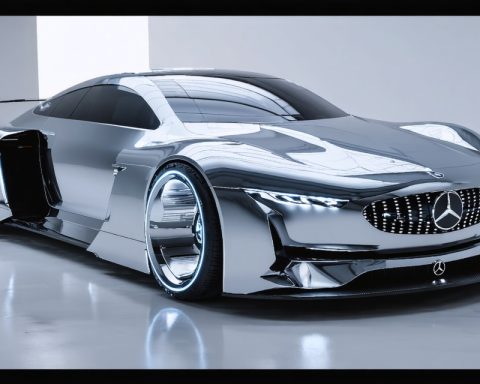- Japan’s automakers like Toyota and Honda face challenges in adapting to the rapidly growing electric vehicle (EV) market.
- Battery technology and software development are crucial, expected to account for up to 50% of vehicle costs by 2030.
- A rapid EV rollout in Europe outpaced Japanese companies, who missed early market shifts, despite their foundational innovations in EV tech.
- Japan’s focus on solid-state batteries offers potential for industry leadership with benefits like reduced weight and increased safety.
- Advanced vehicle operating systems and comprehensive software ecosystems are essential to enhance user experiences and brand loyalty.
- To regain global prominence, Japanese automakers must embrace innovation and adapt quickly to shifting technological trends.
Japan’s automotive titans, once paragons of quality and innovation, now find themselves in the throes of a rapidly evolving electric vehicle (EV) landscape. To reclaim their place atop the global market, names like Toyota and Honda must navigate the transformative waves of battery technology and software supremacy—key factors projected to constitute up to 50% of vehicle costs by 2030.
Why did Japan’s automakers lag in the EV race? An unexpectedly swift EV rollout, notably across Europe, caught many off guard. While initial EV adoption leaned on subsidies, and demand sank with their removal, the inescapable truth is that Japan missed the breaking wave. Meanwhile, companies like Tesla and BYD, unfettered by legacy constraints, poured resources into electric innovation and surged ahead, illustrating a broad industry lag rather than a solely Japanese setback. It’s important to remember, however, that many foundational advances in EV and lithium-ion battery technology originated from Japanese labs.
Yet, the tale need not end in gloom. Japan has a reservoir of technological acumen that can illuminate its path forward. Particularly pivotal are breakthroughs in solid-state batteries—lighter, safer, and capable of longer ranges than their lithium-ion predecessors. Japan’s dedication to this frontier could redefine the industry’s energy standards.
Simultaneously, the auto giants must harness the power of advanced vehicle operating systems. Software now orchestrates everything from infotainment to vehicle safety systems, transforming cars into rolling data centers. Developing proprietary software ecosystems can elevate user experiences and lock consumers into brands with seamless, continuous updates.
To thrive, Japan’s automakers must embrace a mindset unrestricted by their past, seizing contemporary technological and market currents. The path back to global prominence is paved with adaptation—honoring a legacy of innovation by fast-tracking into an electrically charged future.
The quest to “Make Japanese Cars Great Again” is both a return to roots and a leap forward—melding reverence for past breakthroughs with an aggressive drive to master new technologies. It’s a journey demanding bold vision and meticulous execution, a roadmap to set the standard in a future where cars are as much about bytes as they are about horsepower.
Revving Up: How Japan’s Auto Industry Can Dominate the EV Revolution
Introduction
The automotive sector is undergoing a seismic shift with the rise of electric vehicles (EVs), and Japanese automakers, once heralded as global leaders, are finding themselves in uncharted terrain. As the demand for EVs escalates, companies like Toyota and Honda are challenged to innovate rapidly in battery technology and software development—a necessity given the expected rise in vehicle costs due to these components. With Europe and other markets accelerating their EV strategies, how can Japan regain its automotive crown?
Why Did Japan Fall Behind in the EV Race?
1. Reliance on Hybrid Technology: Japan heavily invested in hybrid vehicle technology, which initially seemed a sustainable middle-ground. However, when full EVs turned mainstream faster than anticipated, Japan found itself lagging behind competitors who were scaling up EV production rapidly.
2. Subsidiary Tailwinds and Fair Weather Transparency: Initial EV demand was buttressed by subsidies. As these waned, demand dipped, revealing a discrepancy between policy and production timelines for Japanese manufacturers.
3. Legacy Constraints: Established automakers often wrestle with infrastructural inertia, limiting their agility compared to nimbler, innovative startups like Tesla and BYD, which have fewer legacy systems to overhaul.
Solid-State Batteries: Japan’s Trump Card
Japan’s foray into solid-state battery technology represents a pivotal opportunity. These batteries promise reduced weight, increased safety, and extended range, potentially transforming the EV landscape. Japanese companies can capitalize on their historical strength in material sciences to break new energy efficiency records, making EVs more appealing to a broader audience.
Software as the New Frontier
1. Advanced Operating Systems: The modern vehicle is more akin to a data center on wheels. By developing proprietary software platforms, Japanese automakers can improve user experiences through seamless updates, integrating features like infotainment, vehicle safety, and more.
2. Competitive Integration: A robust software ecosystem can bind consumers to a brand, encouraging loyalty through innovative features and updates that make daily commutes more enjoyable and stress-free.
Strategic Moves for Japan’s Automakers
1. Form Strategic Alliances: Collaborating with tech giants could expedite software development, bridging the gap with competitors that boast advanced in-car technology.
2. Focus on Consumer Education and Infrastructure: Expanding charging networks and educating consumers on the benefits and conveniences of EVs can ease the transition from traditional vehicles.
3. Sustainability and Recycling Initiatives: Leveraging resources for sustainable production processes and effective battery recycling can fortify environmental commitments and appeal to eco-conscious consumers.
Real-World Use Cases
– Fleet Electrification: Japanese automakers have a prime opportunity in urban fleet markets, providing e-mobility solutions for public transport and delivery services, which are pivoting toward electric models to meet emissions targets.
– Emerging Markets: Expanding EV offerings in regions with insufficient infrastructure for internal combustion engines can provide a competitive edge and contribute to wider market penetration.
Upcoming Trends
– Autonomous Driving: Investment in self-driving technology will be crucial. Japan’s automakers should integrate AI capabilities as the demand for autonomous vehicles grows.
– Market Forecasting: Analysts predict that EVs will account for over 50% of all vehicle sales by 2050, with Japan poised to reclaim significant market share through timely innovation and advantageous policies (source: [Bloomberg New Energy Finance]).
Actionable Recommendations
– Accelerate R&D Investment: Investing aggressively in tech R&D can yield proprietary technologies that set industry standards.
– Enhance Supply Chains: Diversifying and securing global supply chains for rare materials and components can mitigate risks related to geopolitical shifts.
Conclusion
Japan’s automakers stand at a crossroads. By leveraging their storied legacy and committing to innovation in EV technology, they can redefine industry standards and seize leadership once more. The road to “Make Japanese Cars Great Again” is laden with promise, necessitating adaptability and tenacity.
Explore More
– Discover more about the advances in EV technology at Toyota.
– Learn how Honda is evolving to meet the changing automotive landscape.
By embracing cutting-edge technology and sustainable practices, Japan’s automotive giants can indeed transform challenges into opportunities, forging a path toward a brighter, electrified future.













